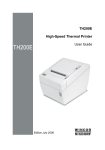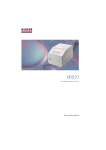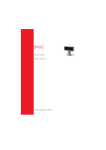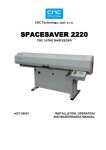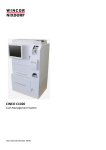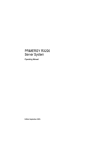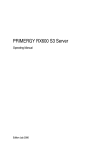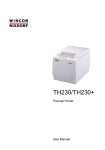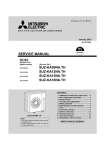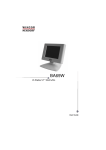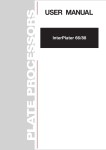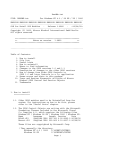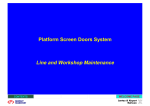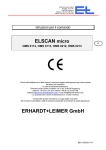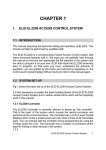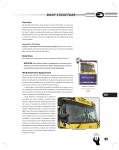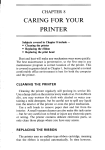Download Modular POS-Printer User Manual Edition
Transcript
ND210 Modular POS-Printer User Manual Edition September 2003 MS-DOS ©, Windows 95, Windows 98SE, Windows 2000Pro and Windows NT are registered trademarks of the Microsoft Corporation BEETLE® is a registered trademark of the Wincor Nixdorf International GmbH Copyright © Wincor Nixdorf International GmbH, 2003 The reproduction, transmission or use of this document or its contents is not permitted without express authority. Offenders will be liable for damages.All rights, including rights created by patent grant or registration of a utility model or design, are reserved. Delivery subject to availability; technical modifications possible. Contents Manufacturer’s Certification ...............................................1 General Licence ..........................................................................................1 FCC-Class A Declaration ............................................................................1 Tested Safety ..............................................................................................1 Important Notes ...........................................................................................2 Introduction..........................................................................4 About this manual........................................................................................4 Care of the ND210 ......................................................................................4 Recycling the ND210 POS Printer ..............................................................5 Warranty ......................................................................................................6 Overview ND210 .........................................................................................7 Installation............................................................................9 Before Switching On....................................................................................9 Unpacking and Checking the Printer .....................................................9 Setting up the device ...........................................................................10 Cabling of the ND210 ................................................................................10 Interfaces...................................................................................................10 Securing the data communication cable..............................................11 Connecting to the mains power supply................................................11 Switch Power ON/OFF ........................................................................12 Disconnecting cables...........................................................................12 Connecting peripherals .............................................................................13 Cash drawer ........................................................................................13 Customer display .................................................................................14 The operator control panel ........................................................................14 ON/OFF ...............................................................................................14 FEED ...................................................................................................15 LEDs ....................................................................................................15 Printer Features .................................................................16 Operating the Printer.........................................................17 Changing the receipt roll ...........................................................................17 Changing the ribbon cassette....................................................................18 Replacing the print head ...........................................................................19 Adjusting the paper near end detector ......................................................20 Adjusting the Paper roll width ....................................................................21 Printing with the ND210.............................................................................22 Software Stamp Printing ......................................................................22 Logo printing ........................................................................................23 Graphics printing..................................................................................23 Appendix ............................................................................24 Technical Data ..........................................................................................24 Paper Specification ...................................................................................25 Receipt paper .....................................................................................25 Print Area (paper roll width of 57.5 mm, 69.5 mm and 76.0 mm)..............26 Interfaces...................................................................................................28 Cash drawer connector........................................................................28 Serial interface to customer display.....................................................29 Serial system interface ........................................................................29 Power supply cable..............................................................................30 Error messages via blink codes ................................................................31 LED “ERROR” .....................................................................................31 Paper Out and Error LEDs are blinking ...............................................33 Receipt cutter-mechanism.........................................................................35 Configuration Tool .....................................................................................36 Print Self Test ......................................................................................37 Print Statistics ......................................................................................37 Cutter Test ...........................................................................................37 Sensor Test .........................................................................................37 Configuration .......................................................................................37 Reset Counter......................................................................................37 Control Sequences ....................................................................................38 GENERAL LICENCE Manufacturer’s Certification General Licence The device complies with the requirements of the EEC directives 89/336/EEC with regard to “Electromagnetic compatibility” and 73/23/EEC “Low Voltage Directive”(in case the device has its own power connection). Therefore, you will find the CE mark on the device or packaging. FCC-Class A Declaration This equipment has been tested and found to comply with the limits for a Class A digital device, pursuant to part 15 of the FCC Rules. These limits are designed to provide reasonable protection against harmful interference when the equipment is operated in a commercial environment. This equipment generates, uses, and can radiate radio frequency energy and, if not installed and used in accordance with the instruction manual, may cause harmful interference to radio communications. Operation of this equipment in a residential area is likely to cause harmful interference in which case the user will be required to correct the interference at his own expense. Modifications not authorized by the manufacturer may void users authority to operate this device. This class A digital apparatus complies with Canadian ICES-003. Cet appareil numerique de la classe A est conforme à la norme NMB-003 du Canada. Tested Safety The ND210 has been provided with the symbol for “Tested Safety”. geprüfte Sicherheit In addition, the ND210 has received the UL symbol and the cUL symbol. R 1 IMPORTANT NOTES Important Notes The accessory printer ND210 is for use with UL listed POS systems and/or UL listed computers. The printer complies with the relevant safety regulations for information technology equipment. Should you have any doubts about the permissibility of installation in a certain environment (e.g. electricity systems, no use of PEN conductors! ), please contact the Wincor Nixdorf Customer Service. n lf the printer is brought into the room of operation from a cold environment, dewfall (condensation) can occur. Before turning on the printer, it must be completely dry; it is therefore necessary to observe an acclimatization period of at least two hours. n When setting up the printer, ensure that there is easy access to the power socket on the printer and/or to the grounded-contact mains socket. Position the leads and cables so that no one steps on or trips over them. n To disconnect the printer from the supply voltage, switch off the printer and disconnect the power supply plug. n Make sure that no objects (for example, paper clips) or liquids get inside the printer. Electric shocks or short circuits can be caused in this way. n Never plug or unplug data communication lines during thunderstorms. n Protect the ND210 from vibrations, dust, moisture and heat. The printer should only be transported in its original packing. This protects the printer against damage from knocks and bumps. n Turn off and unplug the printer immediately if an emergency occurs (for example, if the printer housing is damaged or any foreign substance gets into the printer). Call your Wincor Nixdorf Customer Service. n Always dispose of used parts, such as printer ribbons, in an environmentally safe manner (see chapter “Recycling”). n The ND210 is the result of modern technical innovation. So please see for according structural and technical surroundings to guarantee a faultless and efficient work of your printer. Therefore, you should connect the printer only to power supply systems with separately guided protective earth conductor (PE). This kind of electricity system is known as TN-S network. Do not use PEN conductors! Please also observe the 2 IMPORTANT NOTES recommendations of the norm DIN VDE 0100, Part 540, Appendix C2 as well as EN50174-2, §5.4.3. Thus you can help to avoid possible malfunctions. n The external power supply of the device is equipped with a safety tested cable. The cable may be connected only to a prescribed groundedcontact power socket. The printer may be repaired by authorized qualified personnel only. Repairs made by an unauthorized service provider could not only jeopardize the safety of the user, but could also lead to cancellation of all warranty and liability agreements. 3 ABOUT THIS MANUAL Introduction The modular ND210 Pin Printer is a high-performance and economical POS system printer which is easy to install (plug-in-system), easy to use and which requires a minimum of space. The printer is equipped with connections for a customer display and a cash drawer, which means that the number of interfaces on the system unit of your POS can be increased. Because the industrial standards have been employed - system interface V.24 - the investment you have made for your POS system is protected. With its performance, the ND210 is an essential supplement to your entire point of sale system! About this manual This manual provides you with all the information you require to ensure that your ND210 Printer operates without a single hitch. lt tells you everything you need to do before switching on the printer, how to connect additional devices, and which adjustments might be necessary from time to time to ensure that your ND210 operates reliably. We therefore ask you to read the appropriate sections of this manual before using your printer. Care of the ND210 Clean your printer at regular intervals with a commercially available cleaner for sensitive surfaces. Never use acidic solvents. Before cleaning make sure that the power is switched off, the power supply plug is disconnected and that no moisture gets into the printer. To clean the inner housing use a soft brush or a small vacuum cleaner. Please make sure that there is no remaining paper in the carrier area. Carefully clean the cutter area to remove paper dust. Make sure the ribbon is free of paper dust. 4 RECYCLING THE ND210 POS PRINTER Recycling the ND210 POS Printer Environmental protection does not begin when it comes time to dispose of the ND210; it begins with the manufacturer. This product was designed according to our internal norm “Environmental conscious product design and development”. The ND210 is manufactured without the use of CFCs und CCHS and is produced mainly from reusable components and materials. The processed plastics can, for the most part, be recycled. Even the precious metals can be recovered, thus saving energy and costly raw materials. Please do not stick labels onto plastic case parts. This would help us to re-use components and material. You can protect our environment by only switching on your equipment when it is actually needed. If possible, even avoid the stand-by-mode as this wastes energy, too. Also switch your equipment off when you take a longer break or finish your work. At this time, there are still some parts that are not reusable. Wincor Nlxdorf guarantees the environmentally safe disposal of these parts in the Recycling Center, which is certified pursuant to ISO 9001 and 14001. So don’t simply throw your ND210 on the scrap heap when it has served ist time, but take advantage of the environmentally smart, up-to-date recycling methods! Please contact your competent branch or the Recycling Center Paderborn (for European countries) for information on how to return and re-use devices and disposable materials under the following address: E-Mail: [email protected] We look forward to your message. 5 WARRANTY Warranty Wincor Nixdorf guarantees generally a warranty engagement for 12 months beginning with the date of delivery. This warranty engagement covers all those damages which occur despite a normal use of the product. Damages because of n n n n improper or insufficient maintenance, improper use of the product or unauthorized modifications of the product, inadequate consumables, inadequate location or surroundings will not be covered by the warranty. For further information of the stipulation look at your contract. All parts of the product which are subject to wear and tear are not included in the warranty engagement. Please order spare parts at the Wincor Nixdorf customer service. In case your ND210 works faulty and you are going to send it to the Wincor Nixdorf Customer Service, make sure to remove the printhead before. Our Service then will replace your printer with a faultless ND210 in which you only have to insert your printhead again. Thus you ensure a quick and low-cost repair of the printer. 6 OVERVIEW ND210 Overview ND210 Housing cover Feed roll Paper compartment Paper spring Operator panel Release button Ink ribbon Print head Flap 7 OVERVIEW ND210 DC24V Interfaces 8 RS 232C DISPLAY Type label CASH DRAW BEFORE SWITCHING ON Installation Before Switching On Unpacking and Checking the Printer Unpack the printer and see if the contents of the box matches the particulars on the packing list. Should you notice any n n n transport damages or discrepancies between package contents and delivery ticket or functional defects, please inform your contracting parties or the branch office of Wincor Nixdorf immediately. Please indicate the number of your delivery ticket and delivery ticket position and serial number of the respective device. The serial number can be found on the label illustrated below which is located at the bottom of the housing; it may be necessary to remove the cable cover and storage battery. Wincor Nixdorf 100-120V/ 200-240V 50/60 Hz 5/3 A ND210 017500 000000 0199900107 WN Made in Singapore The serial number is located on the label below the bar code. We recommend saving the original packaging for transport at a later time (protection from impact and shock). 9 CABLING OF THE ND210 Setting up the device Set up the ND210 where it will not be exposed to extreme environmental conditions such as vibrations, dust, moisture, heat and strong magnetic fields. Put the printer on level area. Cabling of the ND210 The printer should be installed in the following order: n n Make sure that the pos system or the power supply is switched off. Plug in the data cables and fasten them. Always make sure that the system is switched off when you do cabling works (except for USB connectors). Interfaces DC24V RS 232C DISPLAY CASH DRAW RJ12 plug cash drawer Interface customer display V24-System interface 24V Voltage in (HOSIDEN connector) 10 INTERFACES Securing the data communication cable Secure interface connectors with knurled screws manually. The interface connectors screws made of metal can be secured with a screwdriver. Screws made of plastic must be secured manually only. HOSIDEN plugs lock in when you insert them. Check the lock by slightly pulling the cable. Maybe you will have to lock the plug by slightly pushing the cable. RJ12 plugs lock in when you insert them. Connecting to the mains power supply You will find a 3pin HOSIDEN socket for the power supply at the back of the ND210 housing . 11 SWITCH THE POWER ON/OFF Connect the ND210 with the POS system via the power supply cable. When using an external power supply unit connect the cable for power supply with the ND210 and plug in the power cable of the unit into a grounded contact mains supply socket. Connect only cable to the 24V connector which are marked with DP-1 or DP-2. Do not connect the HOSIDEN plug when the system is turned on, this can lead to an automatical reboot of the system. By using an external power supply of Wincor Nixdorf the settings in the configuration menu are not necessary. Settings can be done in the configuration tool for external power supply units with more than 72 Watt but without Power ID signal. Switch Power ON/OFF This button switches the power on or off. The device switches off if you press the ON/OFF button for approx. 2 seconds. ERROR ON OFF POWER FEED PAPER OUT Disconnecting cables Never unplug a cable by pulling at the cable itself; always take hold of the actual plug body. Follow the procedure described below when disconnecting cables: n n n 12 Switch off all power and device switches. Unplug all power plugs from the grounded-contact mains power sockets. Unplug all data communication cables from the data networks. CONNECTING PERIPHERALS n Unplug all cables from the devices. With HOSIDEN plugs, the plug remains inserted until released. Pull the plastic covering from the connecting socket with your thumb. The lock is released. The metal of the plug is visible. With HOSIDEN plugs, the plug remains inserted until released. Pull the plastic covering from the connecting socket with your thumb. The lock is released. The metal of the plug is visible. RJ12 plugs lock in when you insert them. To release them push the latch under the plug to the top. Connecting peripherals Cash drawer The ND210 has a RJ12 jack for connecting a cash drawer. To prevent malfunctions, make sure that the connector is plugged firmly into the socket. Power is supplied to the cash drawer via this socket. When connecting cash drawers, the construction level 1 (Release 4) for the KA16 or KA17 is absolutely necessary! The construction level is noted on a label on the bottom of the cash drawer. Connect cash drawers only. 13 THE OPERATOR CONTROL PANEL Customer display The customer display is connected to the serial interface. The interface connection on the ND210 is a 9pin D-sub connector. To prevent possible malfunctions, make sure that the connector for the customer display is plugged firmly into the socket. The power is supplied via this jack. The operator control panel The components which make up the operator control panel include the power switch, LEDs and the paper feed button. The operator control panel is located at the front housing cover of the printer. ERROR ON OFF POWER FEED PAPER OUT ON/OFF This button switches the power on or off. Press the button short for switch on and not less than 2 seconds for switch off. 14 THE OPERATOR CONTROL PANEL FEED Press the receipt feed button once to advance receipt paper one line. The line spacing corresponds to the default value of 1.6". You can also hold down the button to feed receipt paper continuously. LEDs Green LED “POWER” The power light is on when the printer power is on. Red LED “ERROR” This LED is on when the printer cover is open or paper is out. The LED is blinking when an error occurs (see error messages via blink codes on page 30). In normal state the LED is off. Red LED “PAPER OUT” This LED is on when the detector recognized a paper near end or when a paper roll is not installed. The LED is off when paper is available. 15 THE OPERATOR CONTROL PANEL Printer Features The ND210 POS printer has 9dot matrix printing mechanism. Character resolution is 9 x 9 dot matrix or 7 x 9 dot matrix, depending on the character types you select from your application software. The ND210 provides you with the possibility of controlling the line feed of the receipt paper via a button on the operator control panel. For reasons of safety, the printing and cutting devices are shut down as soon as the printer cover is opened. The ND210 is supplied with a Flash EPROM to load in firmware updates without changing the memory device. An individual company logo can be created by means of a block print which is produced in graphic print quality. The logo is loaded into the printer memory through your application software. An individual stamp (software) can be stored in the Flash EPROM of the ND210 permanently. Thus the software stamp will not get lost after the printer has been switched off. Additional printer features are efficient printing and simple operation. You can use paper with different roll width. You can set up the ND210 to run in a quiet mode by using the configuration tool. All consumables for the printer, such as receipt paper or ribbon cassettes can be ordered from Wincor Nixdorf branch office. For the sake of the environment, always dispose of used materials properly (see chapter on recycling). 16 CHANGING THE RECEIPT ROLL Operating the Printer Changing the receipt roll When a red stripe appears on the printed receipt, or the “PAPER OUT” LED lights up on the control panel, a new receipt roll should be inserted. Change the receipt roll as follows: Press the release button at the right hand side of the front and lift up the rear housing cover. Take out the empty paper roll. Insert the new paper roll into the receipt roll compartment, pull out approx. 6 inch (15cm) until it reaches slightly over the front housing cover. Hold the paper while closing the rear housing cover until it clicks in. Tear off the excess receipt paper. 17 CHANGING THE RIBBON CASSETTE Changing the ribbon cassette Switch off the printer. Press the release button at the right hand side of the front and lift up the housing cover. Then lift up the flap. Now you will see the ribbon cassette and the print head. Caution! The print head may be hot! Allow the print head to cool before touching it. Remove the used ribbon cassette. Take hold of the handle bar and withdraw the cassette. Be sure to dispose of the ribbon cassette properly (see also the chapter on recycling). Before inserting the cassette into the printer housing, tighten the ribbon by turning the knob on the cassette clockwise. Grip the cassette on the handle bar and insert it in a way that the guiding pins beside the cassette will slide into the recesses of the ribbon housing. Make sure that the ribbon will be threaded between the guiding pins and the print head. Tighten the ribbon again by turning the knob several times. Close the flap. Pull the receipt paper to front and close the housing cover. 18 REPLACING THE PRINT HEAD Replacing the print head Turn off the power with the power button at the operator control panel. Press the button for at least 3 seconds until the power LED goes off. The print head can be replaced as follows: Press the release button at the right hand side of the front and lift up the housing cover. Then lift up the flap and remove the ribbon casette. Caution! The print head may be hot! Allow the print head to cool before touching it. Remove the ribbon cassette. Take hold of the handle bar and withdraw the cassette. To remove the print head from its bracket, open the holding clips. Press the clips to the left and to the right. The print head is now loose and can be removed easily. Lift the print head only as far as you can unplug the flexible cable from the print head socket. To insert the new print head, follow the same procedure in reverse order. Should you send a faulty ND210 to the Wincor Nixdorf Customer Service, remove the printhead before. 19 ADJUSTING THE PAPER NEAR END DETECTOR Adjusting the paper near end detector The paper near end detector detects when the paper end is almost reached. Software programs can use the ESC c 4 command to enable or disable the paper end recognition. The paper near end sensor is adjusted in the lowest position ex works. Using commercial available paper rolls thus it is insured that an optimal rest of paper will remain on the roll (approx. 1m). The PAPER OUT LED is on when a paper near end is recognized. If you want to change the amount of paper remaining, follow the steps below: n n n n Open the housing cover and remove the paper roll. Slighly loosen the adjusting screw with a coin or a screwdriver. Do not unscrew it! Move the screw to the desired position. A higher position of the screw will remain more paper on the receipt roll. Tighten the adjusting screw. The detector is located on the left hand side of the paper compartment. Adjusting screw 20 ADJUSTING THE PAPER ROLL WIDTH Adjusting the Paper roll width The printer comes along with a paper roll width of 57.5 mm ex works. You will have to move the spacer in the paper compartment when using paper with a different roll width. n n n n Press the release button at the right hand side of the front and lift up the housing cover. Remove the present receipt roll. The spacer is situated on the right side of the paper compartment. Hold down the paper spring (1) and take hold of the grip (2) to remove the spacer upwards (see picture). (2) (1) n The spacer is attached firmly but can be rermoved by hand. Put the spacer in the rear guiding slot in the middle or right position depending on the roll width. Paper roll width of 57.5 mm, 69.5 mm and 76.0 mm n Press down the spacer until it hearable clicks in. 21 PRINTING WITH THE ND210 n Update the settings for the paper roll width with the configuration tool. Please choose: MAIN MENU ->CONFIGURATION ->PRINT SETTINGS ->Paper Roll Width. Change entry to the new width. Printing with the ND210 The ND210 offers you different possibilities to print on receipts: n n text graphics: the software stamp printing, the logo printing, graphics printing Software Stamp Printing If you want to print text or graphics frequently on a receipt e.g. your company name or trademark as header, we recommend to use software stamp printing. Example: You design your trademark by means of a standard graphics software program. In doing so please make sure to create those (bitmap) files as black and white files and to save them later accordingly. The maximum size of a stamp you can print with your ND210 is an area of 25 856 dots. The maximum width (W) is 180 pixel (= 57.44 mm) with a paper roll width of 69.5 mm. The height (H) of the stamp is variable, however, please mind that W x H £ 25 856. If you use paper rolls with a width of 57.5 mm the maximum stamp width is 144 pixel (= 46.24 mm), . paper rolls with a width of 76.0 mm the maximum stamp width is 200 pixel (= 63.84 mm). Having created your bitmap stamp file (black and white!) you then should preferably save it as a black and white file in the same directory in which you already stored the special load software (Flash-ROM Loader Utility) for the stamp file. With this loader utility you can load your file into the Flash EPROM of the ND210. Thus your software stamp remains permanently stored and will not get lost after the printer has been switched off. The stamp will be printed on the receipt by sending the control sequence ESC o. 22 PRINTING WITH THE ND210 You will find details on the “Flash-ROM Loader Utility” and on printing a software stamp in the “ND210 Programmers Guide”. Logo printing The logo print is recommendable for graphics or texts which are often modified and which need not be stored in the printer for a longer period of time. Example: You define a logo which is supposed to appear on the receipt. When designing the logo you will have to adhere to the same parameters as described before when creating a software stamp. Subsequently, the maximum size of your logo is an area of 25 856 dots. The print data will be loaded into the RAM of your ND210 by sending the control sequence GS *. By sending the GS / sequence these data can finally be printed. For further information on the logo printing, please read also the “ND210 Programmers Guide”. Graphics printing In case that stamp and logo printing should not be sufficient, the single-line graphics printing offers another possibility to print frequently modifying data on the paper. In this case the graphics data will be transferred line by line and will not be stored in the printer. The graphics printing is activated by sending the control sequence ESC *. For further information on graphics printing also refer to the “ND210 Programmers Manual”. 23 TECHNICAL DATA Appendix Technical Data Footprint: 24 Height Width Depth 150 mm 160 mm 248 mm Weight (w/o paper) 3,5 kg Climatic Category Operating Temperature IEC 721Class 3K3 +5° to +40°C Power supply 24V / 2.0 A Power approx. 50 watts Print method 9-pin, serial impact dot matrix 9x9 / 7x9 Print columns Receipt max. 40 Print speed: typ. receipt (10 char) 14 lines/sec Logo print (max. size 25 856 dots) via graphic printing quality Ribbon violet System interface Baud rate Parity Handshake 1x RS232c (V24) 4800, 9600, 19200, 38400 none, even, odd DTR/DSR, XON/XOFF Interfaces 1x cash drawers (RJ12) 1x Wincor Nixdorf customer display PAPER SPECIFICATION Paper Specification Receipt paper Roll diameter (outside) max. 83 mm Roll diameter (inside) 12 mm +0, -2 mm Roll width 69.5 ±0,5 mm 57.5 ±0,5mm 76.0 ±0,5 mm Weight 60g/m² ±4% Thickness of paper max. 0.1 mm min. 0.06 mm Useable length of paper approx. 60 m. Red stripes before end of roll. Paper end not glued to core Smooth (Bekk) inside 14 - 56 sec. outside 14 - 40 sec. Fibre-material class z 100 25 PRINT AREA (PAPER ROLL WIDTH OF 57.5 MM, 69.5 MM AND 76.0 MM) Print Area (paper roll width of 57.5 mm, 69.5 mm and 76.0 mm) Set the print area in the configuration tool: MAIN MENU -> CONFIGURATION ->PRINT SETTING -> Paper Roll Width 57,5 mm (32 characters/line) 57,5 46,24 6,6 4,66 RECEIPT 69,5 mm (40 characters/line) 69,5 57,44 6,6 5,46 RECEIPT 26 PRINT AREA (PAPER ROLL WIDTH OF 57.5 MM, 69.5 MM AND 76.0 MM) 76,0 mm (42 characters/line) 76,0 60,96 6,6 8,44 RECEIPT 76,0 mm full (44 characters/line) 76,0 63,84 6,6 5,56 RECEIPT 27 INTERFACES Interfaces Cash drawer connector RJ12 connector pin usage PIN Description 1 Frame Ground 2 Opening pulse for cash drawer 1 3 Status cash drawer 1and 2 4 +24V DC 5 Opening pulse for cash drawer 2 6 Signal Ground 1 6 The Wincor Nixdorf cash drawers KA16, KA17 and KA18 can be connected by cash drawer cables (CR KB - 0930; CR KB - 0930; CR KB - 0941, cable lengths: 0.8m; 1.5m; 5.0m). Connect cash drawers only. 28 INTERFACES Serial interface to customer display Pin assignment for the 9pin D-Sub connector PIN Assignment 1 P12V 2 RXD 3 TXD 4 NC 5 GND 6 NC 7 RTS 8 CTS 9 NC 5 1 6 9 Serial system interface A standard cable for connecting printers to the serial interface is used to connect the ND210 to a PC or a BEETLE system. This cable has a 25-pin D-sub connector for connecting the printer and a 9-pin D-sub connector for connecting the POS system. This connector can be male or female, depending on the systems interface. At the end connecting to the system it has a 9-pin D-sub connector male or female depending on the systems interface. If you want to connect a BEETLE with voltage-supplied COM interface, your local branch office can supply you with the appropriate cable. Gender-changers must not be used. The following illustration shows the connector pin allocation and connection of the cable. 13 25 1 14 29 INTERFACES BEETLE ND210 1 NC 1 NC 2 TXD 2 RXD 3 RXD 3 TXD 4 RTS 4 DTR 5 CTS 5 SG 6 DSR 6 DSR 7 SG 7 RTS 20 DTR 8 CTS 9 NC Cables must be shielded and connected to both connector housings. The data transmission lines are crossed as in a null modem cable. Power supply cable The illustration below shows the Pin assignment of the power supply cable between the ND210 and the BEETLE system. 3 1 2 ND210 24V Input BEETLE 24V Output 1 +24V 1 +24V 2 Ground 2 Ground 3 Power ID 3 Power ID Shell is earth Shell is earth Via the power ID cable the printer will receive information about the value of the power supply unit. 30 ERROR MESSAGES VIA BLINK CODES Error messages via blink codes LED “ERROR” Blinking of the red LED “ERROR” indicates that an error has occured. The respective blink codes are shown graphically in the following section. The blinking cycle lasts about 2 sec. The following error messages can be reset by DLE ENQ 1 or DLE ENQ 2 control command after recovering the error. Automatic cutting error approx. 2 sec. Do not mistake this error for the thermistor error. Home sensor error Carrier detection error Should the errors mentioned above occur, check whether the ribbon is blocking or whether there is residual paper in the printer housing - if so, remove it. 31 ERROR MESSAGES VIA BLINK CODES Cover opened while printing Close the cover. Overheated print head The print head is overheated. The print head have to cool down. If a overheating is happend often the print head must be changed. High voltage error The power supply voltage is extremely high. Low voltage error The power supply voltage is extremely low. In case of errors involving power supply voltage, the power supply unit must be changed. 32 ERROR MESSAGES VIA BLINK CODES Thermistor error The thermistor is malfunctioning or not installed. The foil cable of the print head is malfunctioning or not connected. The cable has to be plugged or must be replaced. Paper Out and Error LEDs are blinking The following errors may occur when switching on the printer, all LEDs will be blinking in a cycle of approx. 4 sec: Hardware error approx. 4 sec. The printer has to be sent to the customer service center. Loading error The printer has to be repaired by service personnel. Firmware error 33 ERROR MESSAGES VIA BLINK CODES When a firmware error occurs (wrong checksum) the blink code will be repeated three times. Subsequently, the printer is in loading mode. It is necessary to load the firmware again. Is it not possible to repair the printer you have to call the service personnel. Checksum error The printer has to be repaired by service personnel. 34 RECEIPT CUTTER-MECHANISM Receipt cutter-mechanism In case of a paper jam or a cutter malfunction, switch off the printer (press approx. 2 sec. the button ON/OFF) and push the power plug. Press the release button at the right hand side of the front and lift up the housing cover. The cutter maybe jamed up the flap, therefore the housing cover is not opened forcibly. Remove the paper jam an switch on the printer. Attention on your hands, they have to be outside the cutter area. The cutter should move to its home position. If the cutter is still visible outside the mechanism (see picture) switch off the printer and Cutter Knurled Wheel Knurled Wheel Cutter turn the knurled wheel for the cutter position upwards or downwards. 35 CONFIGURATION TOOL until the cutter finds its home position inside the cutter-mechanism therefor switch on the printer. n n n Close only the printer when the cutter is in home position. Check by visual inspection, if the cutter is twisted. Take off the housing cover and change the cutter. Make sure, that after trouble shooting the ribbon is clamped. When the cutter does not work exactly, you can deactivate the cutter and manually pull off the paper. You begin with setting the cutter in home position. With the configuration tool you can disable the cutter function. MAIN MENU ->CONFIGURATION ->HARDWARE ->Cutter and set the function to “disable”. Configuration Tool The configuration tool is available by pressing the feed button while switching on the printer. The printer prints this main menu. To choose a submenu, the feed button must be pressed x-times according to the selection digit in the main menu. Every time the feed button is pressed the PAPER OUT LED goes on. To validate the choice the feed button must be pressed for at least one second. 36 CONFIGURATION TOOL Print Self Test The printout shows n the current settings of the printer. n the character set and n the stamp Print Statistics The printout lists the statistical data of the printer components and the specifications of the controller firmware. Cutter Test When the cutter test is choosen, the printer executes 4 halfcuts and then a fullcut. Between the cuts 6 linefeeds will be made. Sensor Test Putting the printer into sensor test mode service personnel may test the sensors manually. Configuration The printer configuration is divided in 3 categories: serial communication, mechanism and hardware as well as print settings. It is possible to switch to the default configuration of the printer. Quiet mode: following the menu items MAIN MENU ->CONFIGURATION ->HARDWARE -> Quiet mode will set the printer in a low noise operating mode. In this mode the printing speed is slightly reduced. Power Supply: following the menu items MAIN MENU ->CONFIGURATION ->HARDWARE -> Power Supply the value of the power supply unit can be set. Reset Counter For statistical data it is possible to reset the counter if defective parts on the printer have been changed. This function is used only by service personnel. 37 CONTROL SEQUENCES Control Sequences The control sequences of the printer controller are based on the ESC/POS standard. The following list shows all the available sequences of the ND210. 38 Code Function HT LF FF CR DLE EOT DLE ENQ DLE DC4 ESC SP ESC ! ESC $ ESC % ESC & ESC * ESC ESC 2 ESC 3 ESC < ESC = ESC ? ESC @ ESC D ESC E ESC G ESC J ESC K ESC R ESC U ESC \ ESC a ESC c 4 ESC c 5 ESC d Horizontal Tab Print and line feed Print and eject document paper Carriage Return Transmit real time status Real time request to printer Turn off the power Set right side character spacing Select print modes (all stations) Set absolute print position Select / cancel user-defined character set Define user-defined characters Select bit image mode Turn on / off underline mode Set 1/6" line spacing Set line spacing Return home Select peripheral device Cancel user defined characters Initialize printer Set horizontal tab position Turn on / off emphasized mode Turn on / off double strike mode Print and line feed Print and reverse line feed Select an international character set Turn on/off unidirectional printing mode Set relative print position Select justification Select paper sensor to stop printing Enable / disable all panel buttons Print and execute n line feeds CONTROL SEQUENCES Code Function ESC e ESC i ESC m ESC o ESC p ESC t ESC u ESC v ESC { GS ENQ GS (A GS (D GS (E GS * GS / GS E GS I GS P GS V GS a GS r Print and reverse feed n lines Execute full cut Execute partial cut Print software stamp Generate pulse (for cash drawer) Select character code table Transmit peripheral device status Transmit paper detector status Turn on / off upside-down printing mode Transmit real time printer status Execute test prints Enable/disable real-time commands Customize NV memory Define downloaded bit image Print downloaded bit image Select print speed and head energizing time Transmit printer ID Set vertical motion unit Select cut mode and cut paper Enable / disable automatic status back Transmit status For programming your printer, please find a detailed description of the control sequences and the character pages in the “ND210 Programmers Guide”. 39 Herausgegeben von/Published by Wincor Nixdorf International GmbH D-33094 Paderborn, D-13629 Berlin Bestellnummer /Order No.: 01750050184B Printed in Germany













































